Naturally durable timber posts performing well
Paul Millen, Clemens Altaner and Harriet Palmer, New Zealand Tree Grower February 2018.
Since 2003, Marlborough-based Vineyard Timbers Ltd has been working to develop an industry based on home grown, naturally durable timber posts for use in vineyards. Between 2006 and 2009, around 1,400 posts were supplied to six vineyard owners in Marlborough’s lower Wairau Valley to see how the posts were performing in service. The vineyard owners were keen to trial an alternative to the radiata pine posts treated with copper-chrome-arsenic and which are commonly used in New Zealand’s vineyards.
This research included a survey of the six vineyards where the durable vineyard posts had been installed. The survey had two aims −
- To gauge the vineyard owners’ experience and opinion of the posts’ performance
- To test the posts for in-ground decay and identify reasons for breakages or other poor performance in situ.
Most of the posts have been in use for over 10 years and vineyard owners and managers have given valuable feedback on their performance compared to various other types of posts available.
A bit of background
Vineyards cover almost 36,000 hectares in New Zealand. Up to an estimated 21 million posts are in use to support vines, by far the majority are radiata pine posts treated with copper-chrome-arsenic or CCA. These CCA-treated posts cause a range of concerns, both for growers and the wider public. They include −
- Unacceptable under organic or sustainable wine production standards
- Brittle and easily broken by mechanical pruners and harvesters
- Broken posts are hazardous and expensive to dispose properly
- Potential toxic leachates from posts could have serious consequences for both soil health and the industry’s market image.
An estimated one million posts, or around five per cent of the total, break and need to be disposed of and replaced each year. In Marlborough, New Zealand’s major wine-growing region, the district council is supporting a proposal to build a pyrolysis plant so the problem of waste posts can be solved. Such a plant may solve the disposal problem, but is already raising negative public reaction and leaves other concerns unaddressed.
Early use of naturally durable posts
Naturally durable timber provides an attractive alternative to CCA-treated posts. Vineyard Timbers Ltd has identified a number of eucalypt species with potential to grow in New Zealand and supply durable timber. The eucalypt timber is naturally durable requiring no chemical treatment, and is also much stronger than radiata pine and so less likely to break when hit by harvesting and pruning machinery.
Between 2006 and 2009, timber from several promising species, including in particular Eucalyptus bosistoana coast grey box, and E. globoidea white stringybark, was recovered from existing mature trees and milled to produce vineyard posts. Based on their durability ratings, the E. bosistoana posts are expected to last at least 20 to 25 years in situ, and the E. globoidea 15 to 20 years. Around 750 E. bosistoana posts, 300 E. globoidea posts, along with 355 posts of other eucalypt species, were purchased by six vineyards in the lower Wairau Valley.
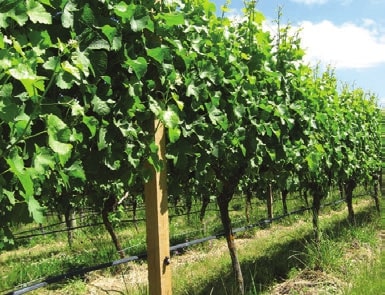
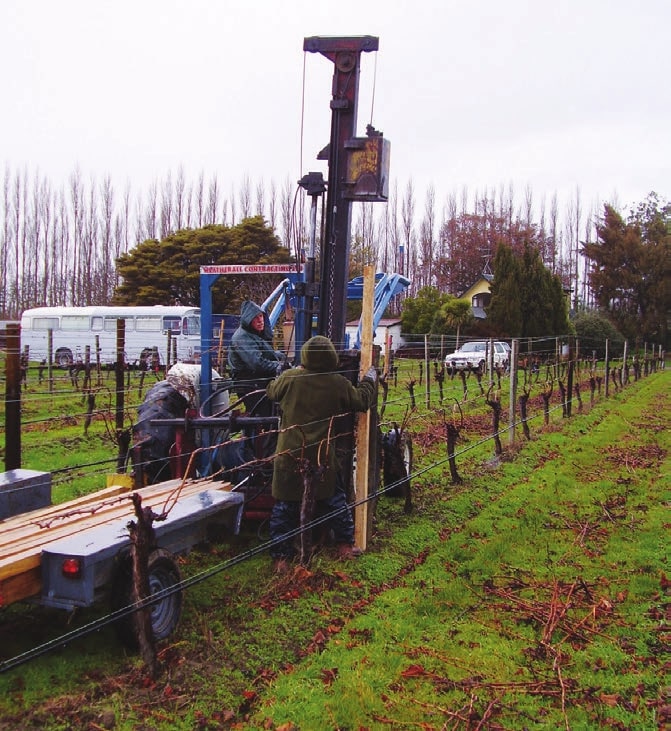
Performance of the durable timber
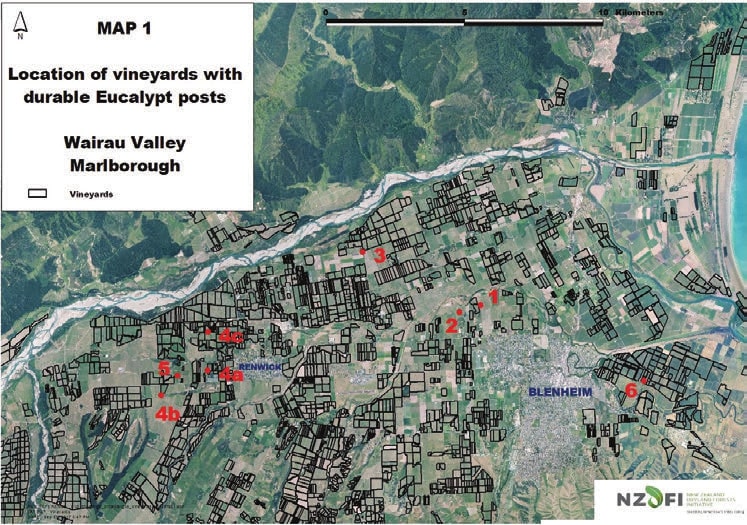
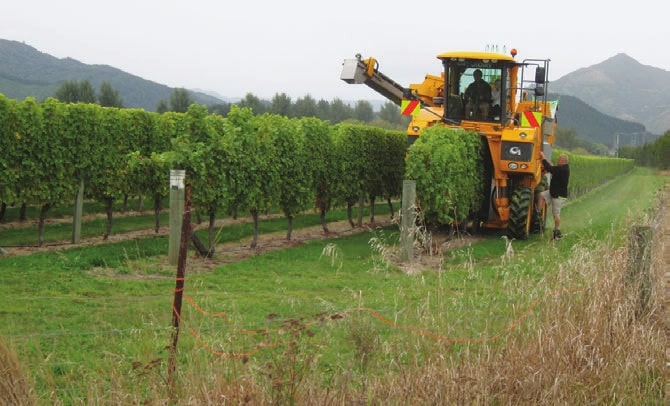
The 2017 survey was of the six vineyard owners or managers who had installed the posts to gauge their experience and opinions and to check the posts still in service. Four of the vineyards had installed the posts as replacements for broken CCA-treated posts, one used them in setting up a new vineyard and another in a small feijoa orchard. Five owners manage their properties under organic standards, with mechanical harvesting and some mechanical pruning. Two also use mechanical cultivation under the vines.
During visits to the vineyards, 1065 posts were found to still be in service. Another 14 were found broken, one failed from decay and 45 in storage.
Post performance
Feedback about the posts was generally positive, thanks to their natural durability and therefore acceptability for organic and sustainable production standards. Four owners said they would use the posts again, especially if supply was local, guaranteed and certified as having come from sustainably managed forests.
Breakages reported were minimal – only 14 in total as mentioned above, and mainly due to large knots in the posts which could easily be avoided in future by quality control. There was one E. globoidea post found which had failed from decay probably due to presence of sapwood.
The main negative comments were about how hard the eucalypt timber is, which makes nailing or fastening wire hangers difficult Pre-drilling was necessary and this is time-consuming although this could be overcome by an innovative technical solution. One owner also found some posts had twisted in storage due to cross grain. Two owners suggested the posts should be larger. Once a greater supply of hardwood is available for producing durable posts quality control will ensure that posts sold meet a product specification
Testing for decay
A sample of 150 posts in service across four vineyards were examined to assess timber condition in the top 200 mm of the soil horizon where maximum decay is likely to occur. Findings included −
- Generally, E. bosistoana posts showed less decay than E. globoidea after between nine and 11 years in service. However, this analysis was a bit confusing as not all sites had posts from both species.
- E. bosistoana posts performed well at both assessed sites with many posts showing no sign of decay.
- Performance of E. globoidea was site specific After 10 years in service E. globoidea posts at one vineyard had severe decay, thought to have been partly due to under-vine cultivation. In other locations the posts were performing well.
The posts assessed in this survey were not part of a dedicated scientific test to assess durability. Instead they were part of commercial vineyard operations.
The feedback from vineyard owners/managers and the results of our decay assessments demonstrate that durable eucalypt vineyard posts provide at least 10 years of useful service with low levels of breakage.
This is encouraging news for the NZ Dryland Forests Initiative, which has several research streams to advance the production and utilisation of naturally durable timber. See www.nzdf.org.nz for more details.
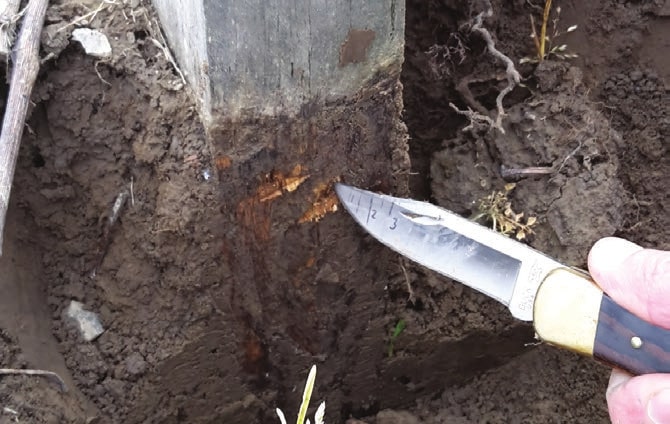
| Posts purchased | Species | Installation date | Posts in service | Posts broken | Posts failed from decay | Posts in storage | Posts unaccounted for | Posts assessed in the ground |
|---|---|---|---|---|---|---|---|---|
| 288 | E. bosistoana | May 2007 | 267 | 8 | 0 | 13 | 0 | 50 |
Case study − Stembridge Vineyards Ltd
Stembridge Vineyard is managed under best practice Sustainable Winegrowing NZ standards. Soils are described by the owner Max Gifford as mixed alluvial silt with gravel ridges. Grapes are machine harvested and a Klimmer mechanical vine stripper is used followed by hand pruning.
Post installation in 2007
A total of 288 E. bosistoana posts were purchased in July 2007. Max included the posts in his own trial of alternative vineyard post. and installed 265 in rows immediately after buying them. Each post alternated with two plastic covered Greenspan steel posts. The unused posts were retained for replacements and 15 were still in stock at the time of the vineyard visit. The remainder of Stembridge Vineyards is installed with CCA-treated pine posts. Plastic posts have been tried and rejected.
Follow-up survey findings in 2017
An analysis of the data collected during inspection of the E. bosistoana posts at Max Gifford’s vineyard is presented at the top of this page.
The total of eight posts broken equates to three per cent of the total of 265 installed 11 years ago. This indicates an annual breakage rate of 0.3 per cent, compared to up to five per cent in conventional CCA-treated pine posts. All but two of 50 posts assessed for in-ground decay showed less than 5 mm of decay, even after 11 years in service.
Feedback from vineyard owner
Max reported that, since installation, there had been a small number of broken posts but no sign of failure from rot. He commented that the posts compared very well with the performance of other posts used in his vineyard which included half round CCA pine posts, steel, plastic and plastic-coated steel posts. The usual causes for failure were breakage from wind and machinery including harvester damage.
Positive points mentioned by Max were ‘long life, uses after removed from vineyard, environmental’. Negatives mentioned were that they were very hard to nail and the surface area could be larger.
Max said he would use the naturally durable posts again. He was not concerned that the posts were not certified as being sustainably produced. However, he did comment that cost has to be taken into account. For example, the plastic-coated steel posts were excellent but too expensive.
More information
A full report of the Marlborough Vineyards survey is available on the NZDFI website www.nzdf.org.nz and for more details contact Paul Millen p.millen@xtra.co.nz or 021 662 147.
Paul Millen is NZDFI/MRC’s Science Leader for the Speciality Wood Products research programme. Clemens Altaner is a wood scientist at the University of Canterbury and their Science Leader for the Speciality Wood Products programme.
The NZ Dryland Forests Initiative update
Interest in growing durable eucalypts for vineyard posts led to the establishment in 2008 of the NZDFI research programme. This is based at the Marlborough Research Centre in Blenheim with the principal research being undertaken in partnership with the NZ School of Forestry at the University of Canterbury. Since 2015 the Forest Growers Levy Trust and other industry supporters have funded the bulk of the research programme via the Speciality Wood Products partnership between Forest Growers Research and Ministry of Building Innovation and Employment.
Research currently under way includes
- Breeding the first generation of improved planting stock, and developing propagation techniques to enable rapid upscaling of superior genotypes
- Site characterisation and growth modelling for different durable eucalypt species
- Managing insect pest risks
- Improving heartwood quality and durability
- Exploring the potential for durable eucalypt timber as a component of laminated veneer lumber.

 Farm Forestry New Zealand
Farm Forestry New Zealand